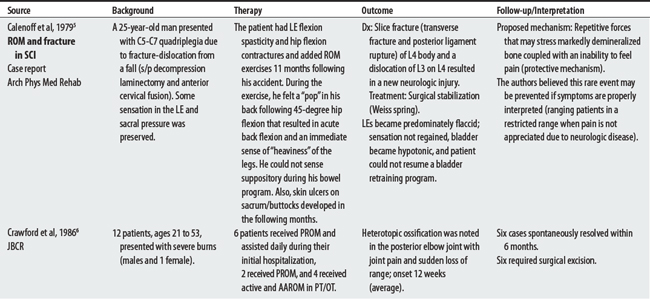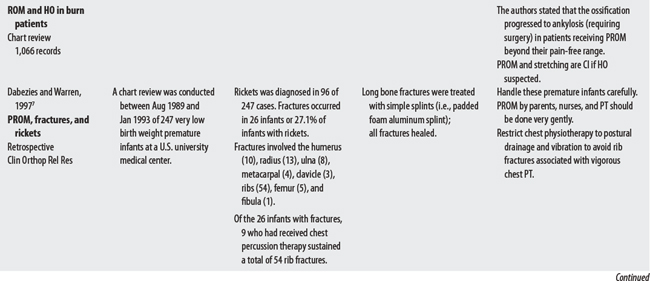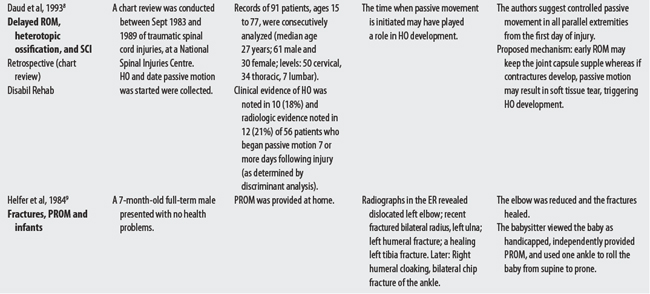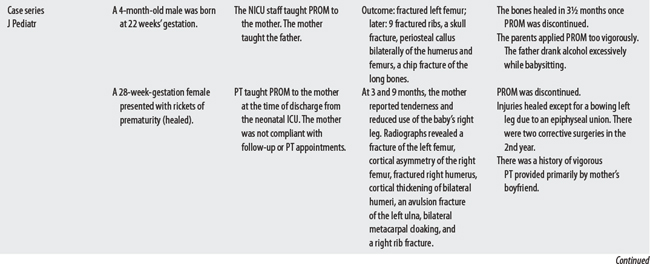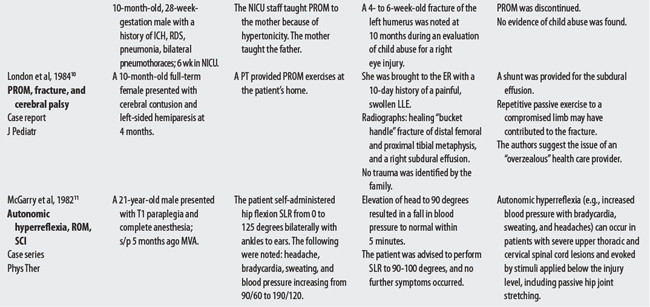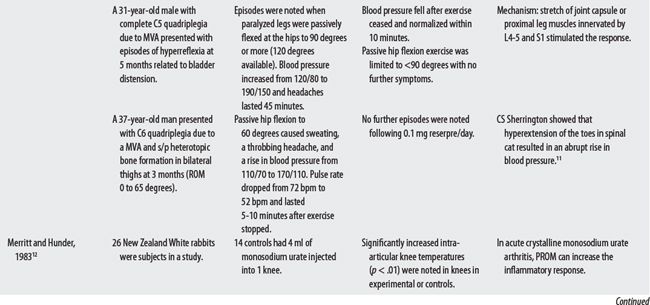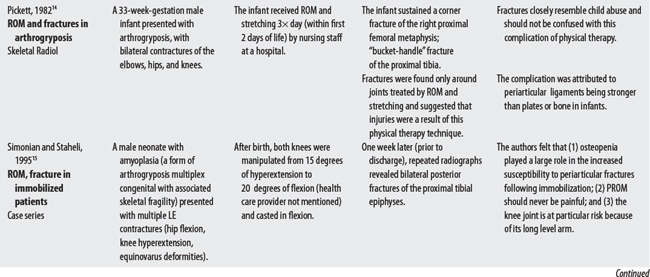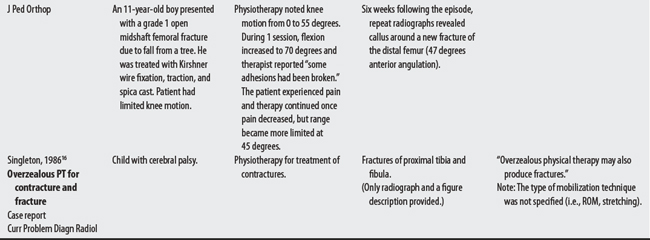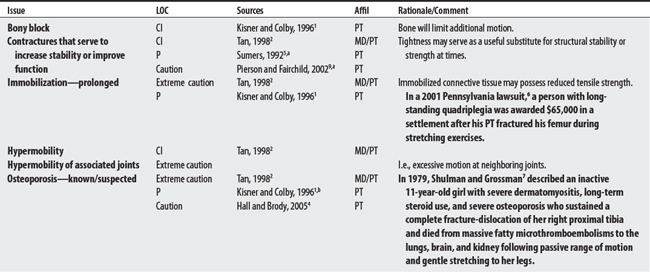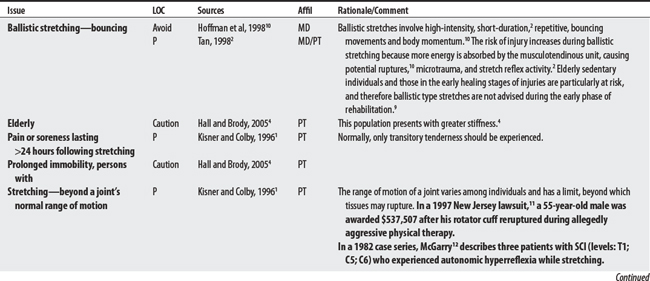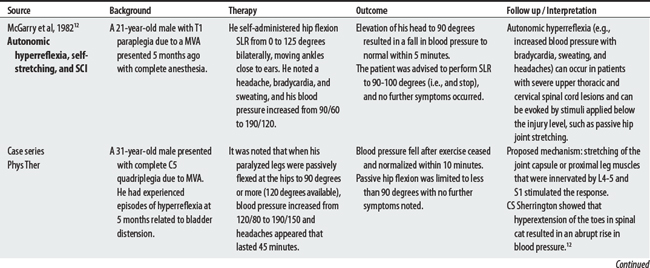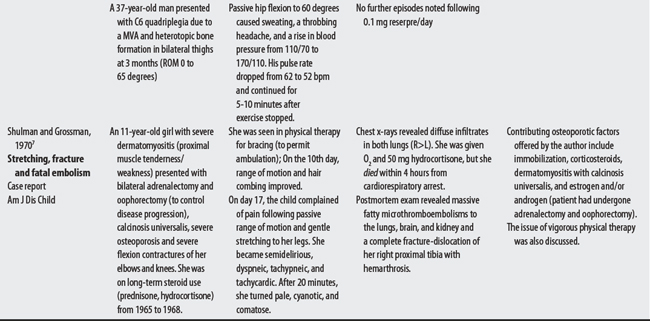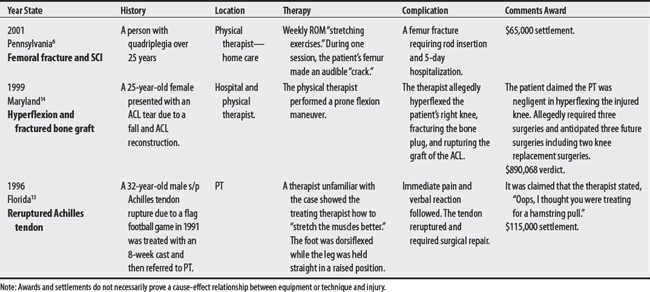Chapter 13 Flexibility Exercises
OVERVIEW.
PROM is motion produced by an external force, without voluntary contraction, and within an unrestricted portion of a joint.1 One of its chief purposes is to maintain (not increase) joint mobility.
SUMMARY: CONTRAINDICATIONS AND PRECAUTIONS.
Four sources list a common contraindication.1–4 PROM is contraindicated if it disrupts healing (i.e., condition intensifies). Complications from PROM are reported below and include (1) fractures/dislocations—in often fragile bone, (2) autonomic dysreflexia—in spinal cord patients, and (3) heterotopic ossification. In addition, overly vigorous techniques may have led to fractures in cases where family members or lay people administer PROM to infants.
1 Monroe LG. Motion restrictions. In Kisner C, Colby LA, editors: Therapeutic exercise: Foundations and techniques, ed 3, Philadelphia: FA Davis, 1996.
2 Tan JC. Practical manual of physical medicine and rehabilitation: Diagnostics, therapeutics, and basic problems. St Louis: Mosby, 1998.
3 Brody LT. Mobility impairment. In: Hall CM, Brody LT, editors. Therapeutic exercise: moving toward function. Philadelphia: Lippincott Williams & Wilkins, 2005.
4 Pierson FM, Fairchild SL. Principles and techniques of patient care, ed 3. Philadelphia: Saunders, 2002.
5 Calenoff L, Geimer PC, Rosen JS. Lumbar fracture-dislocation related to range of motion exercises. Arch Phys Med Rehab. 1979;60(4):183-184.
6 Crawford CM, Varghese G, Mani MM, et al. Heterotopic ossification: are range of motion exercises contraindicated? J Burn Care Rehabil. 1986;7(4):323-327.
7 Dabezies EJ, Warren PD. Fractures in very low birth weight infants with rickets. Clin Orthop Rel Res. 1997;335:233-239.
8 Daud O, Sett P, Burr RG, et al. The relationship of heterotopic ossification to passive movements in paraplegic patients. Disabil Rehab. 1993;15(3):114-118.
9 Helfer RE, Scheurer SL, Alexander R, et al. Trauma to the bones of small infants from passive exercise: a factor in the etiology of child abuse. J Pediatr. 1984;104(1):47-50.
10 London R, Noronha PA, Levy HB. Bone trauma caused by passive exercise. J Pediatr. 1984;105(1):172-173.
11 McGarry J, Woolsey RM, Thompson CW. Autonomic hyperreflexia following passive stretching to the hip joint. Phys Ther. 1982;62(1):30-31.
12 Merritt JL, Hunder GG. Passive range of motion, not isometric exercise, amplifies acute urate synovitis. Arch Phys Med Rehab. 1983;64(3):130-131.
13 Merkx MA, Freihofer HPM. Fracture of costochondral graft in temporo-mandibular joint reconstructive surgery: an unexpected complication. Int J Oral Maxillofac. 1995;24:142-144.
14 Pickett WJIII, Johnson JF, Enzenauer RW. Case report 192. Skeletal Radiol. 1982;8:85-86.
15 Simonian PT, Staheli LT. Periarticular fractures after manipulation for knee contractures in children. J Pediatr Orthop. 1995;15(3):288-291.
16 Singleton EB. Intentional and unintentional abuse of infants and children. Curr Problem Diag Radiol. 1986;15:277-280.
17 Malpractice verdicts, settlements, and experts. February 1998; p. 40
13.2 Stretching
CONTRAINDICATIONS AND PRECAUTIONS
A00-B99 CERTAIN INFECTIONS AND PARASITIC DISEASES
D50-D89 DISEASES OF BLOOD AND BLOOD-FORMING ORGANS AND CERTAIN DISORDERS
M00-M99 DISEASES OF THE MUSCULOSKELETAL SYSTEM AND CONNECTIVE TISSUE
S00-T98 INJURY, POISONING, AND CERTAIN OTHER CONSEQUENCES OF EXTERNAL CAUSES
R00-R99 SYMPTOMS, SIGNS, AND ABNORMAL CLINICAL & LABORATORY FINDINGS (NOT ELSEWHERE CLASSIFIED)
1 Kisner C, Colby LA. Therapeutic exercise: foundations and techniques, ed 3. Philadelphia: FA Davis, 1996.
2 Tan JC. Practical manual of physical medicine and rehabilitation: diagnostics, therapeutics, and basic problems. St Louis: Mosby, 1998.
3 Pauls JA, Reed KL. Quick reference to physical therapy. Austin (TX): Pro-Ed, 2004.
4 Hall CM, Brody LT. Impaired range of motion and joint mobility. In: Hall CM, Brody LT, editors. Therapeutic exercise: moving toward function. Philadelphia: Lippincott Williams & Wilkins, 2005.
5 Sumers MF. Spinal cord injury: functional rehabilitation. Norwalk (CT): Appleton & Lange, 1992.
6 Medical malpractice verdicts, settlements and experts, September 2001, p 46, loc 1.
7 Shulman ST, Grossman BJ. Fat embolism in childhood. Review with report of a fatal case related to physical therapy in a child with dermatomyositis. Am J Dis Child. 1970;120(5):480-484.
8 Maihafer GC. Rehabilitation of total hip replacements and fracture management considerations. In: Echternach JL, editor. Physical therapy of the hip. New York: Churchill Livingstone, 1990.
9 Pierson FM, Fairchild SL. Principles and techniques of patient care, ed 3. Philadelphia: W.B. Saunders, 2002.
10 Hoffman MD, Sheldahl LM, Kraemer WJ. Therapeutic exercise. In Delisa JA, Gans BM, editors: Rehabilitation medicine: principles and practice, ed 3, Philadelphia: Lippincott-Raven, 1998.
11 Medical malpractice verdicts, settlements and experts, September 1997, p 37, loc 3.
12 McGarry J, Woolsey RM, Thompson CW. Autonomic hyperreflexia following passive stretching to the hip joint. Phys Ther. 1982;62(1):30-31.
13 Medical malpractice verdicts, settlements and experts, February 1996, p 44, loc 2.
14 Medical malpractice verdicts, settlements, and experts, July 1999, p 42, loc 1.


